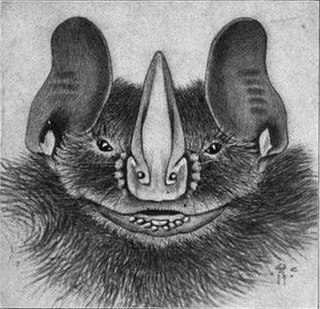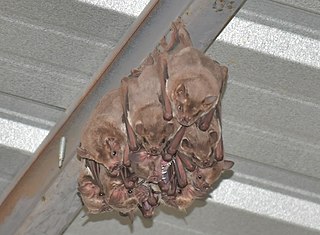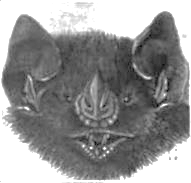
The New World leaf-nosed bats (Phyllostomidae) are found from southern North America to South America, specifically from the Southwest United States to northern Argentina. They are ecologically the most varied and diverse family within the order Chiroptera. Most species are insectivorous, but the phyllostomid bats include within their number true predatory species and frugivores. For example, the spectral bat, the largest bat in the Americas, eats vertebrate prey, including small, dove-sized birds. Members of this family have evolved to use food groups such as fruit, nectar, pollen, insects, frogs, other bats, and small vertebrates, and in the case of the vampire bats, even blood.

The Jamaican, common or Mexican fruit bat is a fruit-eating bat native to Mexico, through Central America to northwestern South America, as well as the Greater and many of the Lesser Antilles. It is also an uncommon resident of the Southern Bahamas. Populations east of the Andes in South America are now usually regarded a separate species, the flat-faced fruit-eating bat. The distinctive features of the Jamaican fruit bat include the absence of an external tail and a minimal, U-shaped interfemoral membrane.

The big-eared woolly bat or (Peters's) woolly false vampire bat is a species of bat, belonging to the Order Chiroptera and Family Phyllostomidae.

The southern yellow bat is a species of vesper bat that belongs to suborder microchiroptera (microbat) in the family Vespertilionidae. It is native to South, North and Central America, from the Rio Grande Valley of Texas in the United States to Argentina.

The dark fruit-eating bat, is a bat species from South America.

The Brazilian big-eyed bat is a species of phyllostomid bat from South America. The scientific name honours Italian naturalist Giacomo Doria.

Andersen's fruit-eating bat is a bat species from South America. It is found in Bolivia, Brazil, Colombia, Ecuador, French Guiana, and Peru.

The silver fruit-eating bat is a South American bat species of the family Phyllostomidae.

The gnome fruit-eating bat is a bat species from South America. It is found in Bolivia, Brazil, Colombia, Ecuador, French Guiana, Guyana, Peru, Suriname and Venezuela. This species was originally discovered to be different from the other known species of fruit bats, but later, in 1994 were mistakenly grouped under Artibeus cinereus as a synonym. However, this has since been corrected by more closely studying their physical differences and by biomolecular analysis.

Dekeyser's nectar bat is a bat species from South America. It is found in Brazil and Bolivia.

The long-legged bat is a member of the Phyllostomidae family in the order Chiroptera. Both males and females of this species are generally small, with wingspans reaching 80mm with an average weight ranging between 6 and 9 grams. The facial structure of these bats includes a shortened rostrum with a prominent noseleaf. The most defining feature of these bats however, is their long posterior limbs that extend farther than most Phyllostomidae bats. At the ends of these hind legs, the long-legged bat has abnormally large feet equipped with strong claws.

The Ipanema bat is a bat species of order Chiroptera and family Phyllostomidae. It is found in South America, specifically in northern Argentina, Bolivia, southeastern Brazil and Paraguay. It is monotypic within its genus.

The great stripe-faced bat or stripe-faced vampire bat is a bat species from South and Central America, where it is found from southern Mexico to Bolivia and northwestern Brazil, as well as on Trinidad. The great stripe-faced bat is a frugivore. It is one of two species within the genus Vampyrodes the other being Vampyrodes major.

The Neotropical fruit bats (Artibeus) are a genus of bats within the subfamily Stenodermatinae. The genus consists of 12 species, which are native to Central and South America, as well as parts of the Caribbean.

The fraternal fruit-eating bat is a species of bat in the family Phyllostomidae that is found in drier habitats in Ecuador and Peru. It was formerly considered to be a subspecies of the Jamaican fruit bat, but was raised to species level in 1978. The smallest species in the group of large Artibeus, it has a forearm length of 52–59 mm (2.0–2.3 in), a total length of 64–76 mm (2.5–3.0 in), and a weight of 30–55 g (1.1–1.9 oz).

The Honduran fruit-eating bat is a species of bat in the family Phyllostomidae. It is found in El Salvador, Honduras, and Nicaragua.

The flat-faced fruit-eating bat is a South American species of bat in the family Phyllostomidae. It is sometimes considered a subspecies of the Jamaican fruit bat, but can be distinguished by its larger size, the presence of faint stripes on the face, and of a third molar tooth on each side of the upper jaw. Genetic analysis has also shown that the two species may not be closely related.

Stenodermatinae is a large subfamily of bats in the family Phyllostomidae.
The Bogota fruit-eating bat is a species of bat found in South America.


















